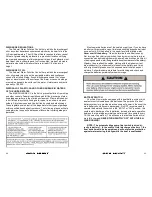
18
GENERAL BOATING INFORMATION
IMPORTANT INFORMATION ABOUT YOUR FUEL SYSTEM:
Beginning in 2009, the United States Environmental Protection
Agency (EPA) began phasing in stricter requirements for marine fuel
systems. These requirements are designed to reduce pollution from
both liquid spillage and evaporative emissions from marine vessels.
Your new Sea Hunt is equipped with the highest quality (USCG rated
A1) low-permeation fuel lines, and either an aluminum or a three-layer
low permeation plastic fuel tank.
Additionally, boats manufactured after March 16, 2012 will be
equipped with an automotive type fuel fill, and a carbon canister in-
stalled in the fuel tank vent system. The fuel fill is designed to activate
the automatic shutoff feature on the delivery nozzle at a predeter-
mined level to ensure that the tank is not overfilled, and to maintain
proper venting. Occasional early shutoffs may occur– this is normal,
just as in your car. Be aware of your beginning and ending fuel level,
though– if you know you have pumped enough to be close to capac-
ity,
DO NOT “TOP OFF”! Intentionally filling to more than rated
capacity will not allow the vent system to function correctly and
could introduce fuel into the carbon canister, requiring replace-
ment of the canister.
Here are some tips to keep your system func-
tioning as designed for a cleaner, greener boating experience:
When fueling on a trailer, fuel with the keel approximately level
with the ground. In the water, this is the natural floating attitude of
your Sea Hunt– just keep it balanced side to side (You should al-
ready have everyone out of the boat when fueling as a normal
precaution).
Make sure you have the dispensing nozzle inserted all the way
into the boat’s fuel fill.
Maintain control of the dispensing nozzle– don’t set the catch (if
equipped) and walk away.
Use a portable container for emergency fueling only. If you have
to use a portable container or fuel caddy to fill your boat, remem-
ber the automatic shutoff will not work, and do not fill over rated
capacity.
When trailering your boat, avoid parking on extreme slopes for an
extended period of time, particularly with a full tank in hot weather.
47
WINTERIZATION AND STORAGE
Make sure the keel, chine and transom are fully supported. In-
door storage is beneficial particularly if your climate produces freez-
ing weather. The storage unit should not be airtight but should be
ventilated. Ventilation is extremely important both around and
through the boat.
For outdoor storage a canvas cover should be used to prevent
“sweating”. One method is to build a frame over the boat to support
the canvas. It should be a few inches wider than the boat so the
canvas will clear the rails and allow passage of air.
The cover should be fastened securely so that winds cannot
remove it or cause it to chafe the boat. A poor covering job will
eventually cost more than the price of a well-made cover.
IF THE BOAT IS SHRINK WRAPPED WITH PLASTIC DURING
STORAGE, THE FUEL FILL AND VENT FITTING MUST BE OUT-
SIDE OF THE ENCLOSURE TO PREVENT THE TRAPPING OF
DANGEROUS FUMES OR SPILLAGE FROM THERMAL EXPAN-
SION.
CLEANING AND LUBRICATING THE BOAT
Clean and wax the boat before storage. If your boat stays in the
water there may be a layer of growth on the bottom. As it dries, this
debris will harden. Clean, scrub, and scrape the bottom promptly
when the boat is removed from the water.
Thoroughly remove all marine growth and other foreign matter
from the hull. Clean the inside of hull openings, thru hull fittings and
scupper drains. Inspect the hull bottom for damage.
Check cleats and rails for corrosion and tightness. Clean all
stainless steel as directed under MAINTENANCE. Use a good qual-
ity metal preservative like T-9® on all metal surfaces to prevent salt
water damage. Check all hinges for corrosion. Lubricate hinges as
necessary. Check for loose silicone, hinges, and unseated gaskets.
Replace or tighten where necessary.
NOTE-
Over time, the normal flexing resulting from regular or
extended operation in heavy seas can result can cause leaks in
your windows, doors and hatches. Inspect for fastener tightness and
seal integrity at regular intervals.
DRAINING AND WATER SYSTEMS
Remove the garboard drain plug and open all valves and sea-
cocks to keep the bilge dry. Store your boat with the bow elevated
for drainage.
Drain all water tanks, lines and pumps to prevent freeze dam-
age. The fresh water system may be drained by running any faucet
until the tank is empty. When empty, turn the faucet off to prevent
pump damage. Residual water will not damage the tank. If desired,















































